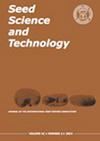墨西哥杜兰戈州干旱地区蓖麻豆种子的形态测定学
IF 3
4区 农林科学
Q2 AGRONOMY
引用次数: 3
摘要
蓖麻产的油籽对工业具有重要的商业价值。本研究的目的是产生在杜兰戈州干旱地区收集的野生蓖麻豆种子大小和形状的形态计量信息,墨西哥。双变量散点图用于确定种子形态计量属性之间可能的关系。主成分分析允许识别三个种子组,高度依赖于形状属性和体积。一组种子体积大,离心率低,圆度高,平整度中等。另一类包括中等体积、高偏心率、中等圆度和高平整度的种子。最后一类种子体积小、偏心、圆润、扁平,分散度高。种子的面积或体积与种子轴线之间的关系表明它们的形状很复杂。对种子大小和形状的了解有助于设计在自然生态系统和农业农场中进行种子处理和储存的技术创新。本文章由计算机程序翻译,如有差异,请以英文原文为准。
Morphometry of castor bean seeds from the Durango State’s arid zone, Mexico
Ricinus communis yields oilseeds of great commercial importance to industry. The aim of this study was to generate morphometric information on seed size and shape of wild castor bean accessions collected in the Durango State’s arid zone, Mexico. Bivariate scatter plots were used to identify possible relationships between seed morphometric attributes. Principal component analysis allowed the identification of three seed groups that are highly dependent on shape attributes and volume. One group involves seeds with high volume, low eccentricity, high roundness and medium flatness. Another group includes seeds with medium volume, high eccentricity, medium roundness and high flatness. The last group involves seeds with small volume, eccentricity, roundness, and flatness with high dispersion. Relationships between seed area or volume with the axes of the seeds suggest that their shapes are complex. Knowledge of seed sizes and shapes can be helpful to design technical innovation for R. communis seed handling and storage in natural ecosystems and agricultural farms.
求助全文
通过发布文献求助,成功后即可免费获取论文全文。
去求助
来源期刊

Seed Science and Technology
农林科学-农艺学
CiteScore
3.00
自引率
28.60%
发文量
36
审稿时长
>36 weeks
期刊介绍:
Seed Science and Technology (SST) is an international journal featuring original papers and articles on seed quality and physiology related to seed production, harvest, processing, sampling, storage, genetic conservation, habitat regeneration, distribution and testing. A journal that meets the needs of researchers, advisers and all those involved in the improvement and technical control of seed quality. Published every April, August and December.
 求助内容:
求助内容: 应助结果提醒方式:
应助结果提醒方式:


